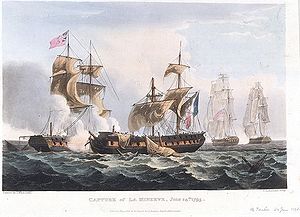HMS Lowestoffe (1761)

Capture of La Minerve off Toulon, June 24th, 1795 by Thomas Whitcombe. In the foreground the damaged and dismasted Minerve duels with HMS Dido, while in the background Lowestoffe pursues a fleeing Artémise.
|
|
| History | |
|---|---|
|
|
|
| Name: | HMS Lowestoffe |
| Ordered: | 15 February 1760 |
| Builder: | Thomas West, Deptford Dockyard |
| Laid down: | 9 May 1760 |
| Launched: | 5 June 1761 |
| Completed: | 1 August 1761 |
| Honours and awards: |
Naval General Service Medal with clasp "Lowestoffe 24 June 1795" |
| Fate: | Wrecked on 11 August 1801 |
| General characteristics | |
| Class and type: | 32-gun fifth-rate frigate |
| Tons burthen: | 717 (bm) |
| Length: |
|
| Beam: | 35 ft 3 3⁄4 in (10.8 m) |
| Draught: | 9 ft 3 in (2.8 m) |
| Depth of hold: | 12 ft 6 in (3.8 m) |
| Sail plan: | Full-rigged ship |
| Complement: | 220 |
| Armament: | |
HMS Lowestoffe was a 32-gun fifth-rate frigate of the Royal Navy. Built during the latter part of the Seven Years' War, she went on to see action in the American War of Independence and the French Revolutionary War, and served often in the Caribbean. Lowestoffe has become famous as the ship in which a young Horatio Nelson served shortly after passing his lieutenant's examination.
Originally commissioned near the end of the Seven Years' War, Lowestoffe patrolled in British waters until 1773, when it underwent repairs. She was recommissioned in 1777 and served throughout the American War of Independence, including at the Battle of San Fernando de Omoa. After the bulk of the fighting ended, she returned home to Portsmouth in 1782, and did not see battle for the next decade. She spent most of her later years in British and Mediterranean waters, winning particular glory for her part in an engagement with two French frigates in 1795. Her final duties were back in the familiar waters of the West Indies, where she was wrecked in 1801 while escorting a convoy in the Caicos Islands.
Sir Thomas Slade based his design for Lowestoffe on that of HMS Aurora, which was a former French vessel named Abenakise. (The Admiralty routinely "took the lines", i.e., drew up blueprints, of captured vessels, and these blueprints were available to designers such as Slade.)
Lowestoffe was the only ship built to her design, though over a decade later the Navy would have two more frigates, HMS Orpheus and HMS Diamond, built to a modification of the design of Lowestoffe and Abenakise. She was ordered on 15 February 1760 from Thomas West, Deptford Dockyard, with West contracted to launch her within 12 months, at a cost of £11.0.0d per ton.Lowestoffe was laid down on 9 May 1760, launched on 5 June 1761 and completed by 1 August 1761. She officially received the name Lowestoffe on 28 October 1760. She had cost a total of £7,715 1s 10¾d to build, coming in just slightly under the contracted price of £7887. The Navy spent a further £4,281 7s 8d on having her fitted out.
...
Wikipedia
